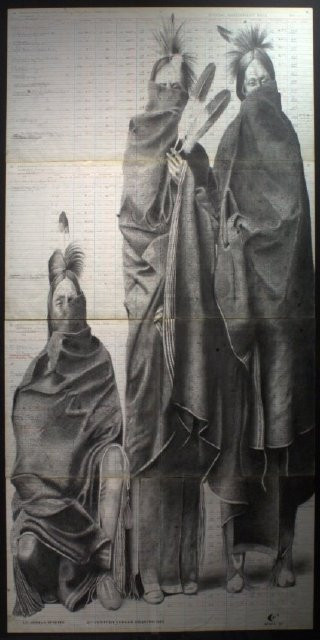Chris Pappan: Ghost Images
April 28 2017 - August 26 2017
Chris Pappan (Osage Nation and of Kaw and Cheyenne River Lakota) grew up in Flagstaff, Arizona, and studied first at the Institute of American Indian Arts (IAIA), then the School of the Art Institute of Chicago. His cited influences are Heavy Metal and Juxtapoz magazines, artist Douglas Miles (San Carlos Apache-Akimel O'odham), who founded Apache Skateboards, and the Lowbrow movement, with its cultural roots in 1970s underground comix, punk, and hot-rod cultures of Los Angeles.
Pappan didn’t grow up on a reservation, but when he moved to Chicago, he found himself in the midst of one of the largest urban Indian communities in the country. More than 30,000 members from 150 different tribes reside in the greater Chicago area as an outgrowth of a 1950s federal program to relocate American Indians from reservations to urban centers in a contested effort to improve access to healthcare, education, and economic opportunities. In the midst of this cultural plethora, Pappan investigated his own background, which he describes as Kaw/ Osage/Cheyenne River Sioux/and mixed European. When he was working as an art handler at a Chicago gallery, Pappan came across an unused accounting book that he adopted as a way to contemporize and reimagine historical ledger drawings.

Chris Pappan, Origins
Pappan uses 19th-century photographs as source material as well. However, his portraits are not exact translations of the photograph, but reveal how mutable—and how concerned with gaze—the medium of portraiture is. Pappan uses post-colonial strategies of depiction—such as mirroring or doubling his subjects, distorting features and proportions, faceting portraits, and reversing values like a photographic negative—to reimagine what otherwise would be a straight-forward rendering of a subject. In doing so, Pappan challenges the Euro-American traditions that favor individual likeness and rely upon linear perspective. Pappan reminds his viewers that there are other ways to see and to depict.
While based in photorealistic portraiture, Pappan uses distortions to refer to complex meanings and convey specific messages. Like historical Plains Indian depictions that visualize elements other than physical features, Pappan’s portraits operate on a metaphysical register and provide a link between the physical and the transcendent. Pappan’s exhibition is the second in a series focused on new work by contemporary American Indian artists generously supported by the Andy Warhol Foundation.

Chris Pappan, Guardian Spirits (21st Century Ledger Drawing #115), 2017, pencil and graphite on Evanston, IL municipal ledger paper, MAM Collection, purchased with a gift from Susan and Roy O'Connor, 2017.11.01, copyright the artist.


